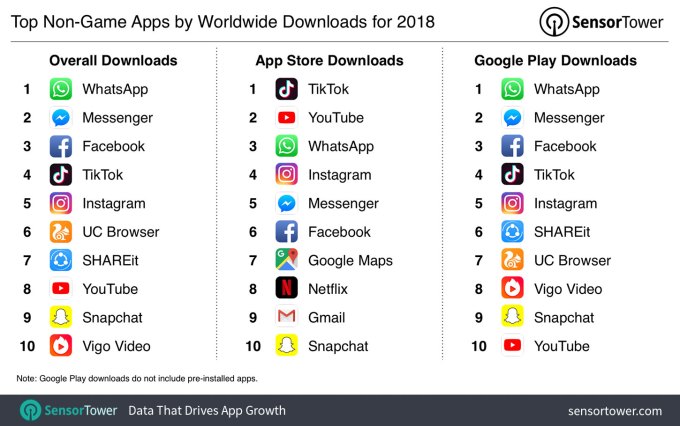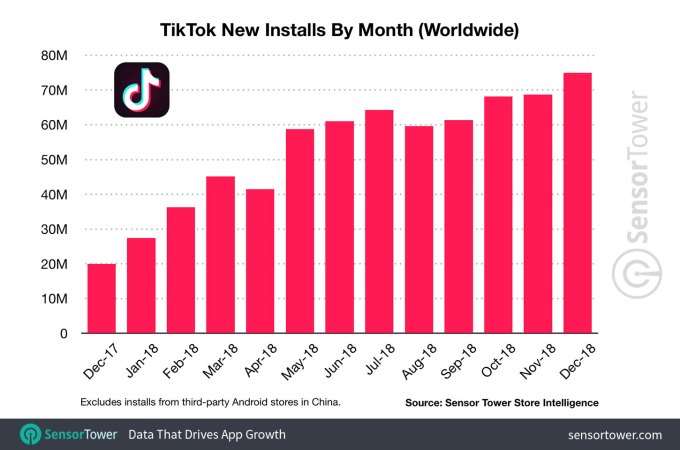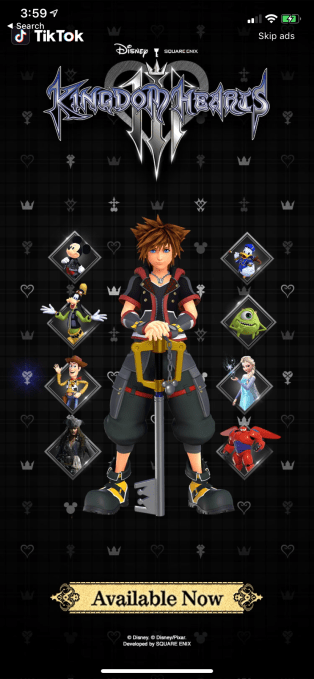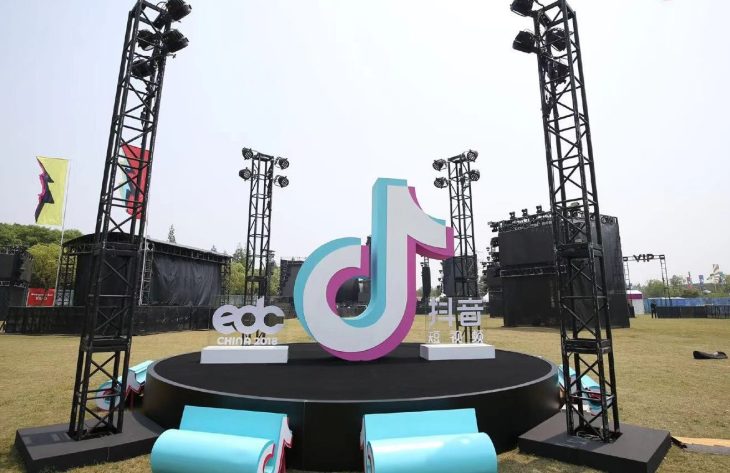Considering that the free flow traffic we used to get on Twitter, Facebook and YouTube are all been interfered with by proto censorship, this is a welcome player that already has one BILLION installs.
In fact i am inclined to find a way to optimize my use of this tool. I need to do short videos anyway showing my efforts to model the Space Time Pendulum and this has already a global reach. After all it is impossible for my blog to be viewed in China and that is annoying.
It is wake up time and we all need to plug in..
.
It’s time to pay serious attention to TikTok
Sarah Perez@sarahintampa / 5 days ago
https://techcrunch.com/2019/01/29/its-time-to-pay-serious-attention-to-tiktok/
If you haven’t been paying attention to TikTok, you haven’t been paying attention. The short-form video app hailing from Beijing’s ByteDance just had its biggest month ever with the addition of 75 million new users in December — a 275 percent increase from the 20 million it added in December 2017, according a recent report from Sensor Tower.
Despite its rapid rise, there are still plenty of people — often, older people — who aren’t quite sure what TikTok is.
TikTok is often referred to as a “lip-syncing” app, which makes it sound like it’s some online karaoke experience. But a closer comparison would be Vine, Twitter’s still sorely missed short-form video app whose content lives on as YouTube compilations.
While it’s true that TikTok is home to some standard lip-syncing, it’s actually better known for its act-out memes backed by music and other sound clips, which get endlessly reproduced and remixed among its young users.
Its tunes are varied — pop, rap, R&B, electro and DJ tracks serve as backing for its 15-second video clips. But the sounds may also be snagged from YouTube music videos (see: I Baked You A Pie above), SoundCloud or from pop culture — like weird soundbites from Peppa Pig or Riverdale — or just original creations.
These memes-as-videos reference things familiar to Gen Z, like gaming culture (see below). They come in the form of standalone videos, reactions, duets, mirrors/clones and more.
The app has been growing steadily since it acquired its U.S.-based rival Musical.ly in November 2017 for north of $800 million, then merged the two apps’ user bases last August.
This gave TikTok the means to grow in Western markets, where it has attracted the interest of U.S. celebrities like Jimmy Fallon and Tony Hawk, for example, along with YouTubers on the hunt for the next new thing.
But unlike Vine (RIP), YouTube or Instagram, TikTok doesn’t yet feel dominated by micro-celebs, though they certainly exist.
Instead, its main feed often surfaces everyday users — aka, amateurs — doing something cute, funny or clever, with a tacit acknowledgement that “yes, this is an internet joke” underlying much of the content.
Okay, okay.
Sometimes these videos are described as “cringey.”
But that’s because those of us trying to talk about TikTok are old(er) people who grew up on the big ol’ mean internet.
Cringey, frankly, is an unfair label, as it dismisses TikTok’s success in setting a tone for its community. Here, users will often post and share unapologetically wholesome content, and receive less mocking than elsewhere on the web — largely because everyone else on TikTok posts similar “cringey” content, too.
You might not know this, however, if your only exposure to TikTok comes from YouTube’s TikTok Cringe Compilations. But spend a day in the (oddly addictive) TikTok feed, and you’ll find a whole world of video that doesn’t exist anywhere else on the web — including on YouTube. Videos that are weird, sure — but also fun to watch.
It’s a stark comparison to the existing social media platforms.
Users today are engaged in the culture wars on Twitter (ban the Nazis! protect free speech!), while YouTubers are gaming the algorithm with hateful, exploitive, dangerous and otherwise questionable content that freaks out advertisers. And Facebook is, well, contributing to war crimes and the toppling of democracy.
Meanwhile, TikTok often presents an alternative version of online sharing. Simple, goofy, irreverent — and frankly, it’s a much needed reset.
For example, some of the popular TikTok memes have included videos of kids proclaiming what a great mom they have, as they drag her into frame, or they remind people to pick up litter and conserve water. They might give themselves silly, but self-affirming makeovers where, afterwards, they cite themselves not as “cute” but rather “drop. dead. gorgeous.”
They might spend hours setting up gummy bears as Adele concert-goers, learning how to do a shuffle dance up a set of stairs or in a dance battle their dad. Or they may showcase some special talent — drawing, painting, gymnastics, dance or skateboarding, perhaps. They do science experiments, make jokes or use special effects for a little video magic.
They shout out “hit or miss!” in public places and wait to see who answers. (Look it up.)
Sometimes it’s dumb, Sometimes it’s clever. But it’s addictive.
Of course, it is still the internet. And TikTok isn’t perfect.
The app has also been the subject of troubling reports about its “dark” side, which is reportedly filled with child predators, devious algorithms, dark patterns, and teens bullying and harassing one another. It’s not clear, however, that TikTok’s affliction with these matters is any worse than any other large, social, public-by-default app of its size.
And unlike some apps, concerned parents — or the users themselves — can set a TikTok account to private, turn off commenting, hide the account from search, disable downloads, disallow reactions and duets and restrict an account from receiving messages.
It is concerning, however, that under-13 kids are setting up social media accounts without parental consent. (But, uh, have you seen Fortnite and Roblox? This is what kids do. At least the TikTok main feed isn’t worrisome by default, we’ve found.)
The bigger issue, though — and one that could ultimately prove damaging to TikTok — is whether it will be able to keep up with content filtering and takedown requests, or handle its security and privacy protection issues as it scales up.

Content and community aren’t the only things contributing to TikTok’s growth.
While Vine may have introduced the concept of short-form video, TikTok made video editing incredibly simple. You don’t need to be a video expert to put together clips with a range of effects. It’s the Instagram for the mobile video age — in a way that Instagram itself won’t be able to reproduce, having already aligned its community with influencers and advertisers.
TikTok’s sizable user base, meanwhile, is due not only to its growth in Western markets, but because of its traction in emerging markets like China and India.
This allowed TikTok to rank No. 4 worldwide across iOS and Android, combined, according to App Annie’s data on the most-downloaded apps of 2018. On iOS, TikTok was the No. 1 most-downloaded app of the year, mainly thanks to China.
At times last year, TikTok even ranked higher than Facebook, Instagram, Snapchat and YouTube.
Both App Annie and Sensor Tower agree that TikTok scored the No. 3 position for most installs among all apps worldwide in 2018.
Now, TikTok is growing in India, says Sensor Tower.
The country accounted for 27 percent of new installs between December 2017 and December 2018, and last month was the source for 32.3 million of TikTok’s 75 million total new downloads — a 25x increase from last year.
Some of this growth comes from ad spend, according to a report from Apptopia, which examined the app’s widened use of ad networks. (It’s also driving people bonkers with its YouTube ads, some of which are highly questionable.).

The revenue is starting to arrive, as well.
Worldwide, users spent $6 million tipping their favorite live streamers, a 253 percent year-over-year jump from December 2017’s total of $1.7 million, Sensor Tower estimates. But live streaming is not the default activity on TikTok — it added the feature after shutting down Musical.ly’s live streaming app, Live.ly.

Above: full-screen ad in TikTok when app is first launched; spotted today
Above: an ad appearing earlier this month
TikTok is also starting to test in-app advertising, and is being eyed by agencies as a result. When you launch TikTok, you may see a full-page splash screen ad of some kind — though the company has not officially launched ad products.

But the brands are starting to take notice. This week, for example, TikTok collaborated with SportsManias, an officially licensed NFL Players Association partner, for the introduction of NFL-themed AR animated stickers in time for the Super Bowl. The move feels like a test for how well branded content will perform within the TikTok universe, but the company says it’s “not an ad deal.”
The company also declined to say how many are today using TikTok.
However, parent company ByteDance had publicly stated last year that it had 500 million monthly active users when it announced the app’s rebranding post-merger. It has yet to release new numbers for its global user base.
That said, ByteDance just shared updated stats for China only, on all versions of the TikTok app (including the non-Google Play Android version). It says that TikTok now has 500 million monthly active users in China alone.
Sensor Tower today estimates TikTok has grown to nearly 800 million lifetime installs, not counting Android in China.
Factoring in those Android in China installs, it’s fair to say this app has topped 1 billion downloads.
Here comes the new new internet, folks. It’s big, dominated by emerging markets, mobile, video, meme-ified, and goes viral both online and off.
So if you haven’t been paying attention to TikTok, you may want to get started.
It’s time to pay serious attention to TikTok
Sarah Perez@sarahintampa / 5 days ago
https://techcrunch.com/2019/01/29/its-time-to-pay-serious-attention-to-tiktok/
If you haven’t been paying attention to TikTok, you haven’t been paying attention. The short-form video app hailing from Beijing’s ByteDance just had its biggest month ever with the addition of 75 million new users in December — a 275 percent increase from the 20 million it added in December 2017, according a recent report from Sensor Tower.
Despite its rapid rise, there are still plenty of people — often, older people — who aren’t quite sure what TikTok is.
TikTok is often referred to as a “lip-syncing” app, which makes it sound like it’s some online karaoke experience. But a closer comparison would be Vine, Twitter’s still sorely missed short-form video app whose content lives on as YouTube compilations.
While it’s true that TikTok is home to some standard lip-syncing, it’s actually better known for its act-out memes backed by music and other sound clips, which get endlessly reproduced and remixed among its young users.
Its tunes are varied — pop, rap, R&B, electro and DJ tracks serve as backing for its 15-second video clips. But the sounds may also be snagged from YouTube music videos (see: I Baked You A Pie above), SoundCloud or from pop culture — like weird soundbites from Peppa Pig or Riverdale — or just original creations.
These memes-as-videos reference things familiar to Gen Z, like gaming culture (see below). They come in the form of standalone videos, reactions, duets, mirrors/clones and more.
The app has been growing steadily since it acquired its U.S.-based rival Musical.ly in November 2017 for north of $800 million, then merged the two apps’ user bases last August.
This gave TikTok the means to grow in Western markets, where it has attracted the interest of U.S. celebrities like Jimmy Fallon and Tony Hawk, for example, along with YouTubers on the hunt for the next new thing.
But unlike Vine (RIP), YouTube or Instagram, TikTok doesn’t yet feel dominated by micro-celebs, though they certainly exist.
Instead, its main feed often surfaces everyday users — aka, amateurs — doing something cute, funny or clever, with a tacit acknowledgement that “yes, this is an internet joke” underlying much of the content.
Okay, okay.
Sometimes these videos are described as “cringey.”
But that’s because those of us trying to talk about TikTok are old(er) people who grew up on the big ol’ mean internet.
Cringey, frankly, is an unfair label, as it dismisses TikTok’s success in setting a tone for its community. Here, users will often post and share unapologetically wholesome content, and receive less mocking than elsewhere on the web — largely because everyone else on TikTok posts similar “cringey” content, too.
You might not know this, however, if your only exposure to TikTok comes from YouTube’s TikTok Cringe Compilations. But spend a day in the (oddly addictive) TikTok feed, and you’ll find a whole world of video that doesn’t exist anywhere else on the web — including on YouTube. Videos that are weird, sure — but also fun to watch.
It’s a stark comparison to the existing social media platforms.
Users today are engaged in the culture wars on Twitter (ban the Nazis! protect free speech!), while YouTubers are gaming the algorithm with hateful, exploitive, dangerous and otherwise questionable content that freaks out advertisers. And Facebook is, well, contributing to war crimes and the toppling of democracy.
Meanwhile, TikTok often presents an alternative version of online sharing. Simple, goofy, irreverent — and frankly, it’s a much needed reset.
For example, some of the popular TikTok memes have included videos of kids proclaiming what a great mom they have, as they drag her into frame, or they remind people to pick up litter and conserve water. They might give themselves silly, but self-affirming makeovers where, afterwards, they cite themselves not as “cute” but rather “drop. dead. gorgeous.”
They might spend hours setting up gummy bears as Adele concert-goers, learning how to do a shuffle dance up a set of stairs or in a dance battle their dad. Or they may showcase some special talent — drawing, painting, gymnastics, dance or skateboarding, perhaps. They do science experiments, make jokes or use special effects for a little video magic.
They shout out “hit or miss!” in public places and wait to see who answers. (Look it up.)
Sometimes it’s dumb, Sometimes it’s clever. But it’s addictive.
Of course, it is still the internet. And TikTok isn’t perfect.
The app has also been the subject of troubling reports about its “dark” side, which is reportedly filled with child predators, devious algorithms, dark patterns, and teens bullying and harassing one another. It’s not clear, however, that TikTok’s affliction with these matters is any worse than any other large, social, public-by-default app of its size.
And unlike some apps, concerned parents — or the users themselves — can set a TikTok account to private, turn off commenting, hide the account from search, disable downloads, disallow reactions and duets and restrict an account from receiving messages.
It is concerning, however, that under-13 kids are setting up social media accounts without parental consent. (But, uh, have you seen Fortnite and Roblox? This is what kids do. At least the TikTok main feed isn’t worrisome by default, we’ve found.)
The bigger issue, though — and one that could ultimately prove damaging to TikTok — is whether it will be able to keep up with content filtering and takedown requests, or handle its security and privacy protection issues as it scales up.

Content and community aren’t the only things contributing to TikTok’s growth.
While Vine may have introduced the concept of short-form video, TikTok made video editing incredibly simple. You don’t need to be a video expert to put together clips with a range of effects. It’s the Instagram for the mobile video age — in a way that Instagram itself won’t be able to reproduce, having already aligned its community with influencers and advertisers.
TikTok’s sizable user base, meanwhile, is due not only to its growth in Western markets, but because of its traction in emerging markets like China and India.
This allowed TikTok to rank No. 4 worldwide across iOS and Android, combined, according to App Annie’s data on the most-downloaded apps of 2018. On iOS, TikTok was the No. 1 most-downloaded app of the year, mainly thanks to China.
At times last year, TikTok even ranked higher than Facebook, Instagram, Snapchat and YouTube.
Both App Annie and Sensor Tower agree that TikTok scored the No. 3 position for most installs among all apps worldwide in 2018.
Now, TikTok is growing in India, says Sensor Tower.
The country accounted for 27 percent of new installs between December 2017 and December 2018, and last month was the source for 32.3 million of TikTok’s 75 million total new downloads — a 25x increase from last year.
Some of this growth comes from ad spend, according to a report from Apptopia, which examined the app’s widened use of ad networks. (It’s also driving people bonkers with its YouTube ads, some of which are highly questionable.).

The revenue is starting to arrive, as well.
Worldwide, users spent $6 million tipping their favorite live streamers, a 253 percent year-over-year jump from December 2017’s total of $1.7 million, Sensor Tower estimates. But live streaming is not the default activity on TikTok — it added the feature after shutting down Musical.ly’s live streaming app, Live.ly.

Above: full-screen ad in TikTok when app is first launched; spotted today
Above: an ad appearing earlier this month
TikTok is also starting to test in-app advertising, and is being eyed by agencies as a result. When you launch TikTok, you may see a full-page splash screen ad of some kind — though the company has not officially launched ad products.

But the brands are starting to take notice. This week, for example, TikTok collaborated with SportsManias, an officially licensed NFL Players Association partner, for the introduction of NFL-themed AR animated stickers in time for the Super Bowl. The move feels like a test for how well branded content will perform within the TikTok universe, but the company says it’s “not an ad deal.”
The company also declined to say how many are today using TikTok.
However, parent company ByteDance had publicly stated last year that it had 500 million monthly active users when it announced the app’s rebranding post-merger. It has yet to release new numbers for its global user base.
That said, ByteDance just shared updated stats for China only, on all versions of the TikTok app (including the non-Google Play Android version). It says that TikTok now has 500 million monthly active users in China alone.
Sensor Tower today estimates TikTok has grown to nearly 800 million lifetime installs, not counting Android in China.
Factoring in those Android in China installs, it’s fair to say this app has topped 1 billion downloads.
Here comes the new new internet, folks. It’s big, dominated by emerging markets, mobile, video, meme-ified, and goes viral both online and off.
So if you haven’t been paying attention to TikTok, you may want to get started.

No comments:
Post a Comment